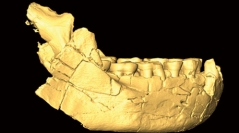

 Comptes Rendus Palevol
18 (8) - Pages 1073-1082
Comptes Rendus Palevol
18 (8) - Pages 1073-1082The present study investigates the inner structural organization of the two mandible specimens Tighenif 1 and Tighenif 2 from the late early Pleistocene site of Tighenif, Algeria. Using (micro)tomographic scans, we built a new protocol to investigate the cortical bone topography at the post-canine level. We selected two cross-sectional slices placed between the P3/P4 and M1/M2 on the right and left sides and assessed the cortical bone thickness topography (CBT) on each slice. Our analyses demonstrate that the mandibles from Tighenif exhibit higher CBT and a different topographic distribution pattern at the molar level than in modern humans, resulting in a proportionally more robust inner structure, while a similar signal is observed between the fossil and extant specimens at the premolar level. Further studies need to be done in order to determine if this feature is related to functional constraints during mastication or paramasticatory activities; or if it is related to any independent evolutionary process.
Mandibular cortical bone thickness, Homo, Late early Pleistocene, Tighenif